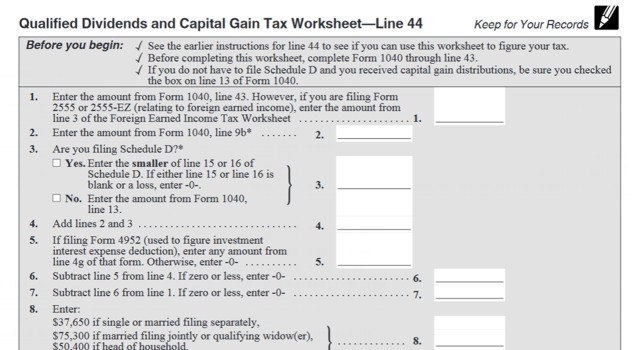This article has been updated to the new line numbers here:
“How Your Tax Is Calculated: Qualified Dividends and Capital Gains Worksheet“

The tax return seems like it should be so easy. It was designed with the intention that citizens who have not learned the mathematics of higher education would be able to fill it out and as you start your way through it the first time it seems like just that. Then, you realize just how many “(see instructions)” notes are in the margin and just how many forms there are and the process gets more daunting.
The strangest fluke of the tax return is that the actual calculation of how much base tax you owe does not have a form. Instead, 1040 Line 44 “Tax” asks you to “see instructions.” In those instructions, there is a 27-line worksheet called the Qualified Dividends and Capital Gain Tax Worksheet, which is how you actually calculate your Line 44 tax.
The 27 lines, because they are so simplified, end up being difficult to follow what exactly they do. So, for those of you who are curious, here’s what they do.
Lines 1-7: Qualified Income & Ordinary Income
There is a sense in which your 1040 Line 43 Taxable Income number is misleading. Your 1040 Line 43 Taxable Income actually has hidden within it your qualified dividends and long-term capital gains, which are taxed at a different rate. So lines 1-7 of this worksheet are figuring what is your total qualified income (line 6) and your total ordinary income (line 7), so they can be taxed at their different rates.
Qualified Income is the sum of long-term capital gains and qualified dividends minus anything you decided to take as income on Form 4952 (don’t do that).
Ordinary Income is then everything leftover, which is Taxable Income minus Qualified Income.
Lines 8-11: Non-Taxable Qualified Income
The first qualified bracket is the 0% bracket, but your ordinary income, even though not taxed at this bracket, fills it up first. Lines 8-11 of the worksheet are figuring how many gains are taxed at the 0% rate (line 11).
Line 11 will either be $0, because your income is already above the 0% bracket, or the top of the 0% bracket (line 8) minus your total ordinary income (line 7).
Lines 12-14: Taxable Qualified Income
Lines 12-14 calculates your Taxable Qualified Income (line 14) by simply subtracting the amount in the 0% (line 11) from your qualified income (line 6) to get the remaining qualified income which will be taxed.
Lines 15-19: 15%-Bracket Qualified Income
All qualified income up to a higher threshold is taxed at the 15% rate, then everything over that threshold is taxed at the 20% rate, but just like the 0% rate, the 15% rate is filled by your ordinary income, even though it is not taxed at this rate.
Lines 15-19 are calculating how much of your Taxable Qualified Income will be in the 15%.
If your ordinary income alone puts you in the 20%, then $0 will be in the lower bracket. Otherwise, your 15%-Bracket Qualified Income is Taxable Income minus both Ordinary Income and Non-Taxable Qualified Income.
For many tax payers, this Line 18 number is either $0 or the same as Taxable Qualified Income (line 4) minus Non-Taxable Qualified Income (line 11).
Line 19 is then the smaller of Total Taxable Qualified Income (line 14) or line 18, which for many tax payers are the same number.
This becomes 15%-Bracket Qualified Income.
Lines 19-23: Qualified Tax
Line 19 is the amount taxed at the 15% rate and Line 22 is the amount taxed at the 20% rate.
The amount taxed at the 20% is everything not already taxed, aka. Total Qualified Income minus Non-Taxable Qualified Income and 15%-Bracket Qualified Income.
Line 21 is your 15% bracket tax. Line 23 is your 20% bracket tax.
Lines 24: Income Tax
Line 24 is where you put your income tax owed. There is no worksheet for this. You have to tax your total ordinary income (line 7) through the income tax brackets.
Lines 25-27: Total Tax
Line 25 adds together your 15% bracket tax (line 21), your 20% bracket tax (line 23), and your income tax (line 24).
This is almost always your tax.
There’s a sidestep though where in line 26, they ask you to tax your total taxable income through the income tax brackets (again no worksheet) to see if it is lower. If it is lower, you get to keep this tax amount.
Line 27 is then your Tax to put on 1040 Line 44.